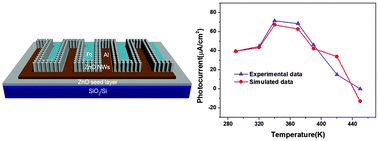Self-powered ultraviolet photodetectors based on selectively grown ZnO nanowire arrays with thermal tuning performance
Abstract
A self-powered Schottky-type ultraviolet photodetector with Al–Pt interdigitated electrodes has been fabricated based on selectively grown ZnO nanowire arrays. At zero bias, the fabricated photodetector exhibited high sensitivity and excellent selectivity to UV light illumination with a fast response time of 81 ms. By tuning the Schottky barrier height through the thermally induced variation of the interface chemisorbed oxygen, an ultrahigh sensitivity of 3.1 × 104 was achieved at 340 K without an external power source, which was 82% higher than that obtained at room temperature. According to the thermionic emission–diffusion theory and the solar cell theory, the changes in the photocurrent of the photodetector at zero bias with various system temperatures were calculated, which agreed well with the experimental data. This work demonstrates a promising approach to modulating the performance of a self-powered photodetector by heating and provides theoretical support for studying the thermal effect on the future photoelectric device.


 Please wait while we load your content...
Please wait while we load your content...